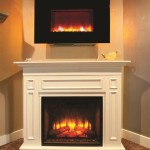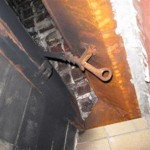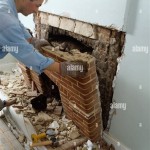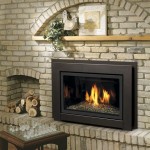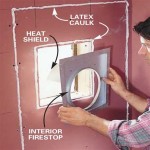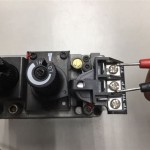Fireplace Damper Chainsaw: A Specialized Tool for Chimney Maintenance
The term "fireplace damper chainsaw" represents a niche application of chainsaw technology, specifically designed for modifying or removing fireplace dampers that are damaged, stuck, or require replacement. While not a standard tool readily available in hardware stores, the concept involves adapting a chainsaw, often a smaller, more maneuverable model, to cut through the metal components of a damper system within a chimney. This specialized task necessitates a thorough understanding of fireplace mechanics, chimney construction, and chainsaw operation, coupled with strict adherence to safety protocols.
Traditional methods of damper removal often involve manual tools like chisels, hammers, and occasionally welding equipment. However, these methods can be time-consuming, physically demanding, and potentially damaging to the surrounding brickwork or chimney liner. In situations where a damper is heavily rusted, seized in place, or otherwise inaccessible, a modified chainsaw can offer a more efficient and precise cutting solution. However, it is crucial to emphasize that this technique should only be employed by trained professionals who possess the necessary skills and experience to mitigate the inherent risks.
The use of a chainsaw in this context deviates significantly from its primary application in felling trees or cutting lumber. The confined space of a chimney flue, the presence of combustible materials (soot and creosote), and the potential for damaging the chimney structure all contribute to the elevated risk associated with this practice.
Understanding Damper Function and Failure
A fireplace damper is a crucial component of a chimney system, serving to regulate airflow between the interior of the home and the external environment. When the fireplace is not in use, the damper should be tightly closed to prevent heat loss during winter and to keep out unwanted drafts, pests, and debris. Conversely, when a fire is burning, the damper must be fully open to allow for proper ventilation and the safe escape of combustion byproducts, such as smoke and carbon monoxide.
Damper failure can manifest in several ways. A common problem is rusting or corrosion due to exposure to moisture and acidic flue gases. This can cause the damper plate to seize, making it difficult or impossible to open and close. Another issue is warping or distortion of the damper plate, which prevents a tight seal and results in air leakage. In some cases, the damper mechanism, such as the handle or linkage, may break or become detached, rendering the damper inoperable.
A malfunctioning damper can lead to various problems. An open damper allows heated air to escape from the home, increasing energy consumption and heating costs. It can also create uncomfortable drafts and allow cold air to enter. A closed damper, on the other hand, can prevent proper ventilation during a fire, leading to smoke buildup in the room and the potential for carbon monoxide poisoning. Furthermore, a damaged damper can become a fire hazard if it obstructs the flow of smoke and allows creosote to accumulate in the chimney.
Modifying a Chainsaw for Damper Removal
The modification of a chainsaw for fireplace damper removal involves several key adaptations to enhance safety and precision. Firstly, the chain itself is often replaced with a specialized chain designed for cutting metal. These chains are typically made from a harder alloy steel and have a different tooth geometry compared to standard wood-cutting chains. This allows them to effectively cut through the metal components of the damper without excessive wear or breakage.
Secondly, the chainsaw's bar, which guides the chain, may be shortened or replaced with a narrower bar to improve maneuverability within the confined space of the chimney flue. A shorter bar also reduces the risk of accidental contact with the chimney walls or liner. The lubrication system of the chainsaw may also be modified to use a specialized cutting fluid suitable for metal cutting, which helps to cool the chain and prevent overheating.
Finally, and perhaps most importantly, safety features are often added to the chainsaw to minimize the risk of kickback and other hazards. These features may include chain brakes, hand guards, and anti-vibration systems. In addition, the operator must wear appropriate personal protective equipment, including a face shield, hearing protection, gloves, and a respirator, to protect against flying debris and fumes.
It is critical to emphasize that any modification of a chainsaw should be performed by a qualified mechanic or technician who understands the potential safety implications. Improper modifications can compromise the chainsaw's functionality and increase the risk of accidents.
Safety Protocols and Considerations
The use of a chainsaw for fireplace damper removal presents significant safety challenges that must be addressed meticulously. Prior to commencing any work, a thorough inspection of the chimney and damper system is essential. This inspection should identify any potential hazards, such as structural weaknesses, loose bricks, or an excessive buildup of creosote. If significant creosote deposits are present, the chimney should be professionally cleaned before any cutting takes place, as creosote is highly flammable.
The work area should be properly ventilated to prevent the accumulation of fumes and dust. A portable ventilation system or exhaust fan may be necessary to ensure adequate airflow. It is also crucial to protect the surrounding area from sparks and debris. Fire-resistant blankets or tarps should be used to cover furniture, flooring, and other flammable materials.
During the cutting process, the chainsaw operator must exercise extreme caution to avoid damaging the chimney walls or liner. The chain should be kept sharp and properly tensioned to ensure clean, controlled cuts. The operator should also avoid applying excessive pressure to the chainsaw, which can cause the chain to bind or break. It is important to make slow, deliberate cuts and to regularly inspect the chain for signs of wear or damage.
Perhaps the most critical safety consideration is the risk of fire. Sparks generated by the chainsaw can ignite creosote or other combustible materials in the chimney. Therefore, a fire extinguisher should be readily available at all times, and a second person should be present to monitor the work area and provide assistance in case of an emergency. After the cutting is complete, the chimney should be thoroughly inspected for any signs of smoldering or fire.
Furthermore, proper disposal of the removed damper components is essential. Metal scraps can be sharp and hazardous, so they should be handled with care and disposed of in a safe and responsible manner.
In conclusion, the "fireplace damper chainsaw" represents a specialized and potentially hazardous application of chainsaw technology. While it can offer an efficient solution for removing damaged or stuck dampers, it should only be employed by trained professionals who possess the necessary skills, experience, and equipment to mitigate the inherent risks. Strict adherence to safety protocols is paramount to prevent accidents and ensure the integrity of the chimney system.
Before undertaking any work on a fireplace damper, homeowners should consult with a qualified chimney sweep or fireplace technician to assess the situation and determine the most appropriate course of action. In many cases, alternative methods of damper removal may be safer and more cost-effective than using a modified chainsaw.

Fireplace Damper Repairs Pt 6 Of 9 Drilling The Mounting Holes

Chimney Damper Repair Fix A Broken

Chimney Damper Repair Fix A Broken

1 Set Damper Spring Shock Buffer For Chainsaw 45cc 52cc 58cc 4500 5200 5800

Chimney Damper Repair Fix A Broken

Locktop Chimney Damper Tight Top 8x8

Fireplace Damper Repairs Pt 6 Of 9 Drilling The Mounting Holes

Darco Heat Resistant Elements For Connecting The Fireplace Straight Chimney Damper

Chimney Damper Repair Fix A Broken

Top 5 Gas Chainsaws Of 2024
Related Posts

